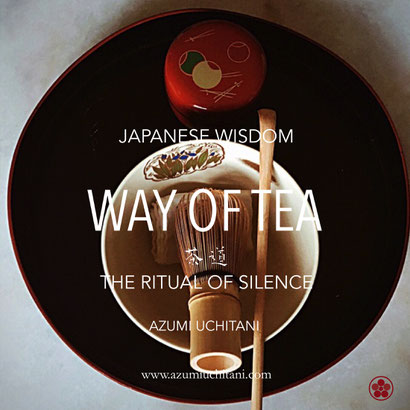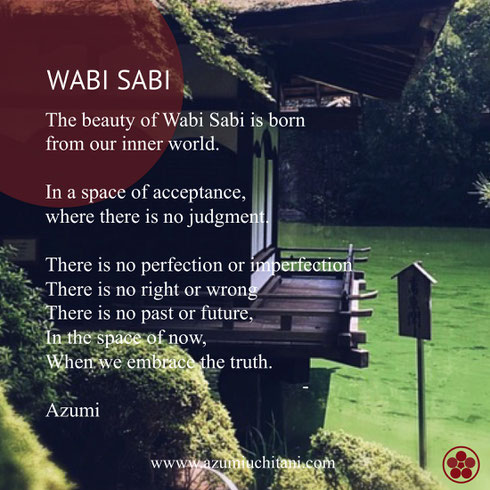
Japanese tea ceremony
Japanese Tea Ceremony, (茶道) Way of Tea is a ritual of preparation and presentation of tea making with “Matcha” (the powder made from the finest green tea leaves).
It is a cultural, spiritual and social activity practiced in Japan, based on the philosophy of Zen Buddhism with the influence of Shinto.
It is a practice and discipline to quiet our mind, empty our thoughts, totally be in the present moment to appreciate the time and space – Ichi Go Ichi E (一期一会), this very occasion will happen only once. We humbly become a part of nature as we celebrate the season. Every item we use in the tea ceremony represents its season, from the teacups, flowers, art to Kimono we wear.
The sound of a raindrop can be a beautiful addition to the moment.

These four principles are the centre of the tea ceremony
- 和 (wa) HARMONY : to be harmony with ourselves, nature and seasons
- 敬( kei) RESPECT : respect and give gratitude to everything around us.
- 清 (sei) CLEANNESS: clean and purify our inner and outer world.
- 寂 (jaku)TRANQUILITY : Be in the stillness and tranquility
The tea ceremony is not taught by a book. It is to be learned by doing and being and felt in our hearts.
The purpose is to experience this state of peace within ourselves and purify our energy, our inner self.
Every movement of preparing tea is like a flow of dance, creating the silence within and out.
In the silence, we discover all, where the truth is.

How it started...

Japanese tea drinking started in the 9th century and evolved and developed into a process of personal spiritual transformation practice.
In the 16th century, when the tea ceremony “Wabi Cha” was established by Sen Norikyu,
He has perfected it to the Tea ceremony rituals “Way of Tea” and spread to the society in Japan with the philosophy “Ichi go Ichi e “ One meeting, one time - to appreciate fully in the present moment, as this moment will never happen again.
The Wabi Sabi asthetic was introduced. It was a spiritual discipline to create inner peace, silence, stillness to immerse ourselves into the beauty of quietness, stillness and emptiness where our heart is not disturbed from any stimula. Or we could say, our heart is in total harmony with ourselves and also with outer world. To be one, as in the Zen circle.
Tea Ceremony

The host will prepare the room.
Simply place the art and flower arrangement that represents the season.
Guests come in and all will be seated.
The host will clean all the utensils to purify - guests will watch in silence,
Tea will be made
The host will serve sweets and tea. Guests will receive tea and drink.
All the movements are like a dance. It hasn’t changed for 500 years.
It is not a perfection of traditional rituals but simply to transcend and unite with the soul by freeing our mind and all intellectual conceptual thoughts.
Wabi Sabi

Wabi Sabi is translated as finding the beauty in imperfection, but it is not a true understanding of Wabi Sabi.
The beauty of Wabi Sabi is born from our inner world.
The inner world which we created during the tea ceremony.
In a space of acceptance, where there is no judgment.
There is no perfection or imperfection
There is no past or future.
Three is no beauty or ugliness
There is no right or wrong
There is no name or title,
In the space of now, we hold nothing.
Just pure self, our essence,
everything is as it is.
In this quiet peaceful space within, we embrace a sheer joy.
Beauty in the silence, where the truth is.
The aesthetics and definition of wabi-sabi is the state of our mind that is at point zero, void, free from conceptual thought and judgement and enable us to embrace and cherish all as it is.
In the eyes of Wabi Sabi, there is no imperfect or perfect. Only the truth exists.
To truly experience Wabi Sabi, we need to clean our inner and outer world and be with inner peace. Tea Ceremony is the practice to create this state of being.
Way of Tea and Tea ceremony is the practice to create this state of being - peace within ourselves and being harmony with nature. It is a beautiful path with tenderness, like a circle, there is no end.
We become the observer of the present moment.
Azumi's "Way of Tea" in Holland
I have practiced Omote Senke style, the traditional Tea ceremony in Wakayama, Japan under my life time master who is now 78 years old. Being encouraged by my master, here in the Netherlands, I started sharing the experience of tea ceremony and teaching its very essence in a way we can adopt to our daily life, inviting all walks of life, from school children to corporate executives. I use the Bontemae method in which we can enjoy on the table.
The very essence of tea ceremony is the inner peace in our heart, creating harmony in our inner world and outer world.
With the silence we create, we become more peace and more compassionate to ourselves and to others.







